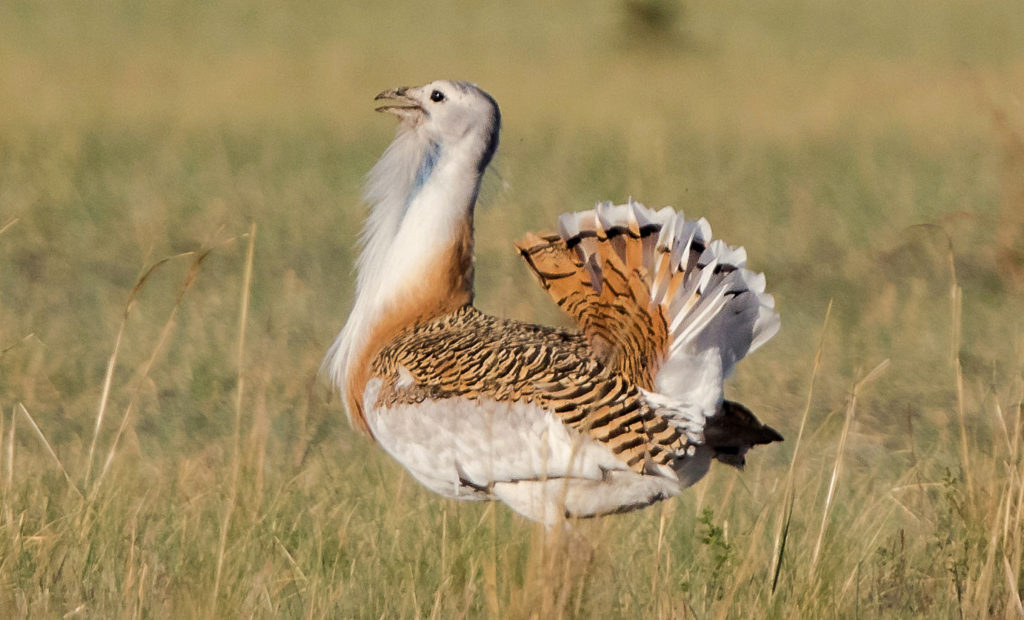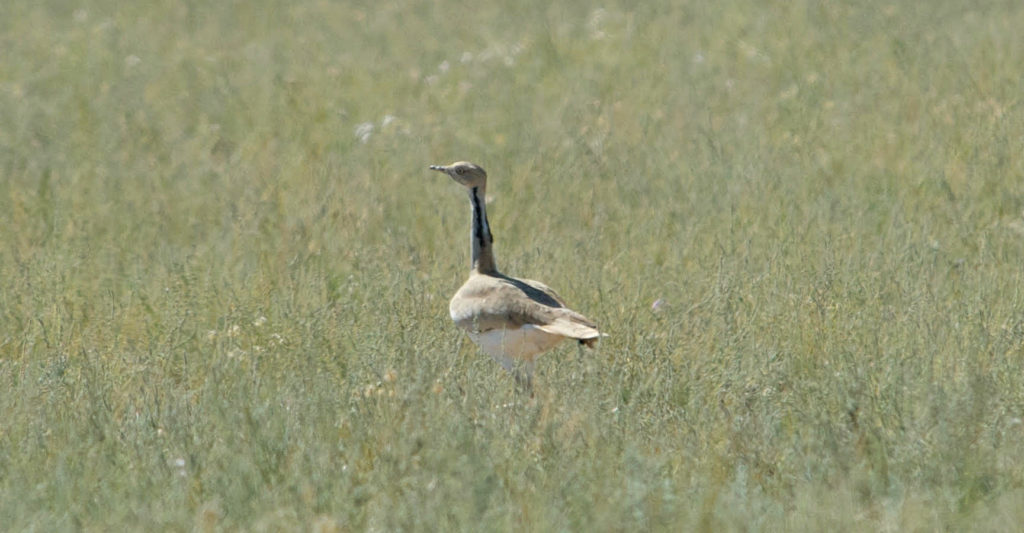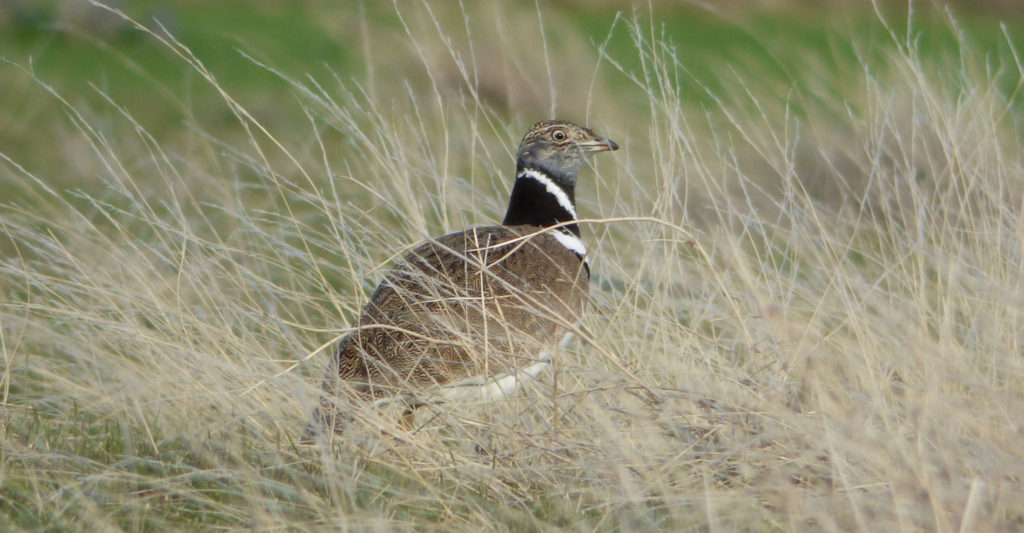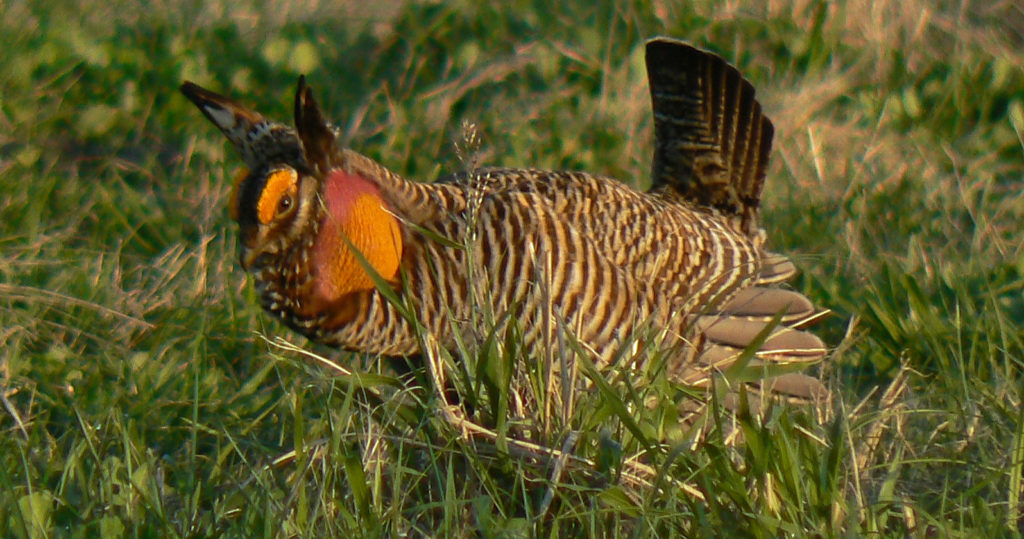The Bustard family (Otididae) consists of 27 species of heavy-bodied birds, found on four continents—Africa, Asia, Australia, and Europe. Though their appearance may be compared to cranes or ostriches, recent genetic evidence suggests that the bustard family is most closely related to turacos and cuckoos. Bustards are omnivorous—preferring insect or small vertebrate food when it is available.
Though they are typically seen striding across dry, open landscapes, bustards are also strong fliers. In fact, the bustard family includes the two heaviest species capable of flight – the Great Bustard and Kori Bustard.
Bustards perform some of the most unusual and spectacular breeding displays in the animal kingdom. Most bustard species participate in a “lek” breeding system, in which males gather to perform displays that involve contortion of the body, inflation of air sacs, twirling, jumping, or running. Females observe the males and choose with which to mate. Females then go on to incubate eggs and raise their chicks singly, while males continue to display. This mating system has resulted in high levels of sexual dimorphism – differences in size and coloration between the sexes – in many bustard species.
Bustards have three short, frontward facing toes that are incapable of clutching a branch – meaning that these birds must nest on the ground. Their eggs and chicks are frequently destroyed by predators or human activities, including livestock herding and mechanized agriculture.
The populations of most bustard species are declining, due to low rates of reproduction combined with high rates of adult mortality. Adults die due to hunting, trapping, poisoning, and collisions with power lines. Many species range long distances over the course of a year, meaning that they are susceptible to dangers across a wide swatch of territory.
Great Bustard

The Great Bustard is a bird of superlatives. Males of this species reach 21 kg (45 lbs), making them the heaviest birds capable of flight. Females, however, weigh only 5-7 kg (11-15 lbs). Key to this dramatic difference – the most extreme sexual size difference seen in birds – is the unusual mating system of the Great Bustard.
Female bustards choose a mate on the basis of his appearance and mating display, which is performed at traditional sites each spring. The result of generations of female-choice? Super-sized males with striking red coloration, capable of performing a complex display involving contortion of the body and inflation of a specialized throat sac.
Unfortunately, severe population declines over the past 100 years mean that few people now observe the intricate display of the Great Bustard. The species has declined across its range, becoming extinct in some European countries.
The Asian subspecies of Great Bustard, found only in Mongolia, China, and Russian South Siberia, is of special concern. Though few surveys have been undertaken in Mongolia, the population has been estimated at less than 2500 birds. These bustards are particularly at risk as Mongolia transitions from communism to a free-market economy, replete with road construction, increased natural resource development, and land privatization.
Threats to the Great Bustard are numerous. Bustard nests, simple scrapes in the ground, are destroyed by the activity of agricultural machinery in the fields they inhabit. The insect food base so important to the rapid growth of chicks is eliminated with pesticides. Though they are strong fliers, heavy-bodied bustards are not maneuverable enough to avoid collisions with powerlines. And though now illegal, hunting by humans also plays a role in these declines. Our team is working to quantify the risks to bustards in Central Asia, and we communicate with local people and conservation agencies to develop conservation plans.
Great Bustard Links
Meet the Great Bustards we are monitoring
Video of a Great Bustard practicing his display at our field site [.mov]
Asian Houbara (MacQueen’s Bustard)

Evolutionarily, Houbara are the most closely related species to the Great Bustard, though they are much smaller. The Asian Houbara Bustard was recently split from the African Houbara Bustard, and is now considered a separate species. These birds prefer arid habitats and are found from the Sinai Peninsula eastward through the Gobi Desert.
Male Houbara perform a captivating and unusual breeding display, in which they jog about with their eyes obscured by decorative feathers. Like Great Bustards, they are largely silent.
Populations of both Houbara species are highly sought after as prey by falconers. Houbara populations in many regions have plummeted as equipment for hunting has become more technologically advanced and hunters travel greater distances to reach remaining populations. Captive breeding centers using artificial insemination raise and release Houbara in some parts of their range.
Little Bustard

This small bustard species (< 1kg) has a large breeding range in Kazakhstan and southwestern Russia and the Caucasus, as well as western Europe. The Little Bustard prefers agricultural habitats used at low intensity, such as cereal fields farmed with fallow rotations and pastures used for livestock. Thus, the species has suffered from agricultural intensification, including irrigation, overgrazing, and use of farming machinery which crushes eggs.
Males have an attractive black collar around the neck. During the breeding season, males gather at lekking sites to perform a display which involves raising their collars, stamping, clicking, and making small jumps.
Ecologically Similar Species

Although there are no members of the Bustard family in the New World, some species have a similar breeding biology or fill a similar ecological niche:
Turkey: Like Great Bustards, Wild Turkeys are heavy bodied. However, whereas Wild Turkeys fly only short distances, the Bustards we monitor are strong fliers that migrate long distances. The male Turkey, like the male Great Bustard, attracts females by contorting his tail and shivering his feathers. Turkeys were promoted by Benjamin Franklin as the national bird of the US. The Great Bustard, for its part, is the national bird of Hungary, honored on the crest of Wiltshire in the UK, and is considered a flagship species for grassland conservation.
Sage Grouse: Like Great Bustards, Sage Grouse gather on traditional breeding grounds called “leks” each spring to carry out their courtship displays. Bustards and Sage Grouse both prefer open habitats and suffer declines from land-use change and habitat loss.
Prairie Chickens are also lekking birds of open grasslands. The prairie chicken mating display involves leg stomping and strutting. This impressive performance is honored in dances of Native American Plains Indian tribes. Like the Great Bustard, Prairie Chicken populations have suffered from overhunting and habitat change. Read the story of “Booming Ben,” who died on Martha’s Vinyard in 1932, as the last individual of the northeastern subspecies of the Prairie Chicken.
Bustards in the News
- Little Bustard nests in Kyrgyzstan after thirty years absence
- New genome assembly for the Eastern Great Bustard
- Extensive surveys of Little Bustard wintering in Azerbaijan
- Eastern Great Bustard migration routes mapped
- Little Bustard resumes breeding in Kyrgyzstan
- Endangered great bustards make spring journey back to nature reserve in N China’s Inner Mongolia
- Seasonal protected area proposed for wintering Great Bustards in Beijing
- One-third of Crimea’s Great Bustard population poisoned
- A Houbara Bustard breeding center is planned for Kalmykia
- Man killed after filming hunting of Houbara Bustards in Pakistan













